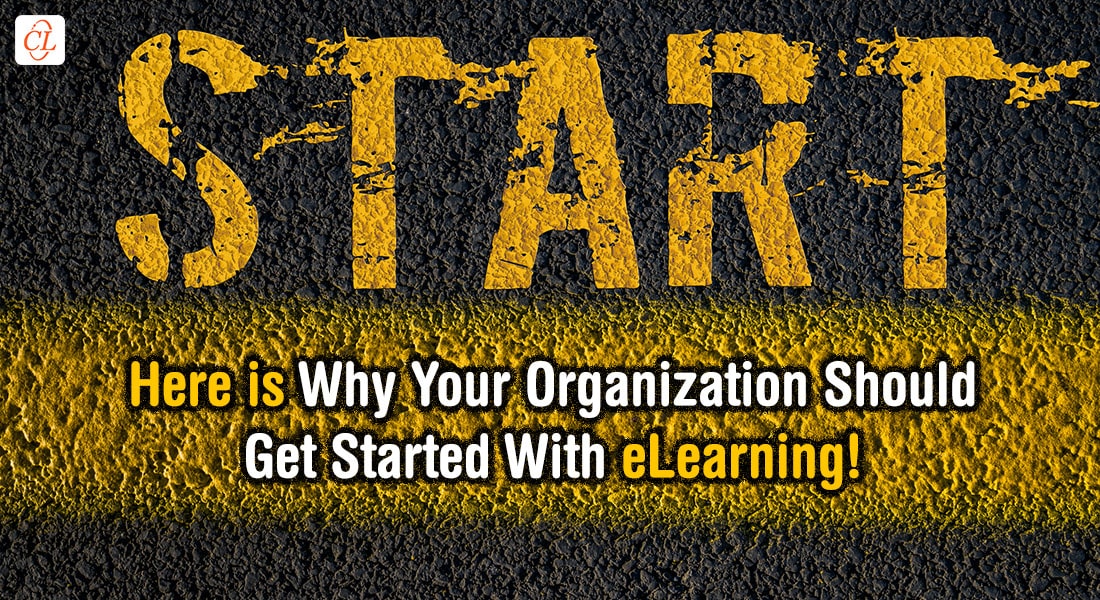Why Should Organizations Get Started with eLearning?

As per a report published by Statista Research Department on July 6, 2022, eLearning is growing rapidly and is expected to have a market value of $400 billion by 2026. That’s over 900% growth since 2000, evenly distributed between academic institutions and organizations. While online learning had already gained traction, the growth increased several-fold due to the COVID-19 pandemic.
The teachings during that time were eye-opening, especially given the innovation in the industry. According to an IBM study, organizations gained an additional $30 in productivity for every $1 spent on online learning. Furthermore, the Research Institute of America this learning mode reduces employee training time by 60%, a significant percentage considering how often training needs to be conducted.
Hence, it is profitable for organizations to incorporate eLearning to perform better. However, exploring the numbers isn’t a convincing argument, which is why we have written this blog. It will mention different forms of eLearning and explain the organizational benefits of relying on this training method.
Why Should Organizations go for eLearning?
Core reasons for its increasing popularity:
- Higher accessibility
- Attention optimization
- Cost-effectiveness
- Greater content engagement
- Training adaptability
Read on to explore the other benefits offered by eLearning.
Top eLearning Forms
eLearning may have gained a significant market value, but it is still in its infancy in terms of potential. However, researchers have still managed to introduce several great forms that organizations can choose depending on the training type they are conducting.
Following are the top eLearning forms that are popular right now:
1. Microlearning
Microlearning is one of the most effective training formats, especially for today’s millennial-dominated workforce with dwindling attention spans. Microlearning delivers small bite-sized learning nuggets, each addressing a single learning objective. Popular microlearning assets are infographics, short videos, flashcards, interactive PDFs, podcasts and more. It makes learning effective as the microlearning assets are engaging and are accessible to learners anytime, anywhere. Microlearning is an ideal way to impart just-in-time learning and boosts retention.
2. Gamification
Gamification converts training into games linked to reward systems, utilizing learners’ interest in playing games to make them concentrate. The knowledge is structured to help people learn while playing the game, boosting trainee understanding and retention.
3. Mobile Learning
Mobile learning is compatible with microlearning so that you can use them together without concerns. It describes online training sessions that can be accessed through mobile phones. The goal is to increase the likelihood of employees taking the training no matter where they are.
4. Virtual Reality
Virtual reality is mostly used when employees need to learn about a manufacturing component or similar elements. While taking the entire team to the plant for training isn’t always convenient, it is possible to leverage VR to help them explore it in detail from the comfort of the office.
This technology is critical for operations and can affect how well they understand the machinery they work with.
Why Organizations Should Get Started with eLearning
The blog’s introduction mentions the monetary benefit due to online training, but there is likely confusion about why such it happens. Following are the core reasons why eLearning is critical for organizations of all sizes:
1. Higher Accessibility
Firstly, eLearning is a lot more accessible than traditional learning. The courses are available online, so the employee can take the training from the comfort of their home, during their free time, or from their offices. Additionally, you also don’t need a specific computer to access them.
They are available on the internet, so you can access them wherever you are, as long as you have a working internet connection. Your data will automatically be recorded against your system profile to improve things, showing your progress.
2. Attention Optimization
eLearning can be extremely engaging. As it is based on the principles of instructional design and leverages the power of authoring tools, it offers learners with engaging content. The various interactivities in the form of scenarios, games, videos, and simulations binds learner attention throughout the course and ensures effective learning.
3. Cost-Effectiveness
Online training is one of the most cost-effective training solutions. It does not require dedicated classrooms, desks, chairs, refreshments, etc., saving a tremendous cost your organization would otherwise incur. It is also inclusive, allowing people with flexible work conditions to work from home.
It will help you save more over the years.
4. Greater Content Engagement
eLearning content, whether microlearning or gamification, is designed with the best features and text. The graphic design strategy maximizes audience engagement and pushes people to give more time and attention to the organization.
This engagement is valuable because it can often indicate whether or not a customer will purchase the product or service.
5. Training Adaptability
The latest eLearning solutions often have artificial intelligence embedded in the software. This technology tracks your training performance, attentiveness, and similar elements, using machine learning to adapt it to maximize training success.
This adaptability is a primary reason most people learn more and finish their training faster.
6. Learning Analytics for Each Employee
Aside from training adaptation, the online training software options provide objective and measurable data analytics. You can use these analytics to study learning patterns among employees.
The strategy will help identify which areas each employee struggles with, the system providing useful ideas for restructuring. Therefore, you can leverage it to adjust the course structure for each team member to increase knowledge retention and training effectiveness.
7. Self-Paced Learning
A core reason for eLearning’s popularity is that it is self-paced. Since training is online, managers or team leaders can tell their team members deadline for training completion. After that, it is up to the employee to choose their preferred pace removing the pressure from their shoulders.
This sense of control and self-determination is critical for their personal and skill development and allows them to explore responsibility.
8. Lower Employee Turnover
It may seem like an odd result but introducing eLearning has helped reduce employee turnover significantly. As mentioned above, online training methods are adjusted for higher audience interest, knowledge retention, and learning patterns.
These factors allow employees to enjoy the mini-training sessions and notice their effectiveness in real-time. This success serves as a motivation, with better performance and productivity helping them improve their overall evaluation.
These elements increase their happiness, lowering their likelihood of leaving the organization.
9. Adapted to Latest Technology
Lastly, eLearning results from technological advancement; therefore, the method is good at incorporating the latest developments in its framework. This adjustment is also good for organizational training because it allows employees to interact with technological innovations and observe their applications.
This exposure is beneficial because it provides new ideas and inspires their creativity and innovation. These qualities boost their productivity and help them seek more learning.
Summing it up!
In a nutshell, incorporating eLearning into your organizational training framework will boost productivity and performance. It will also lower employee turnover, reduce training costs, and increase knowledge retention. Therefore, it is critical to include it in your training strategy to reap its manifold benefits.
If you are looking forward to incorporating eLearning in your corporate training, here’s an eBook that can help you with a comprehensive guidance.





